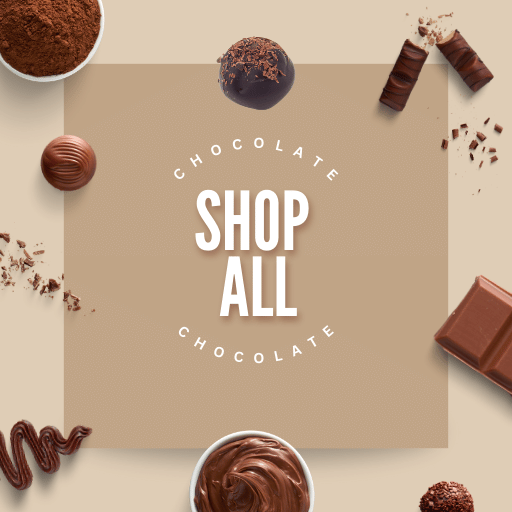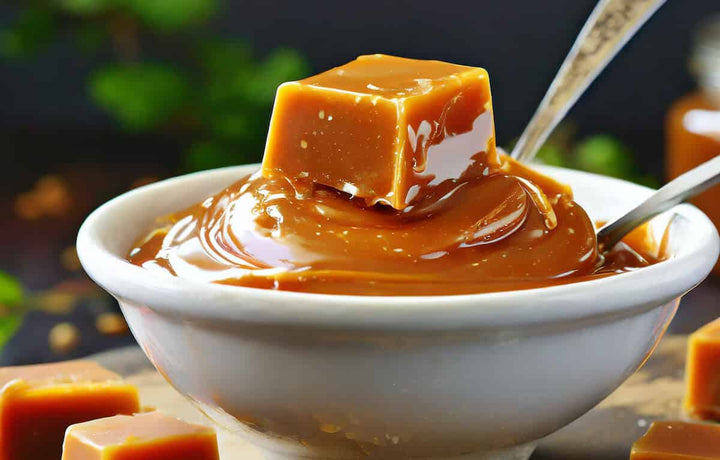Toffee, a classic confection that has delighted sweet tooths for generations, is a staple in candies and desserts. But what exactly is toffee?
From its humble beginnings to its current status as a versatile and cherished treat, toffee’s journey is as rich and exciting as its flavour.
Whether you’re a long-time fan or new to the world of toffee, join us as we unwrap the delicious details of this traditional British sweet.
What is Toffee?
Toffee is a confectionery made primarily from sugar and butter, known for its rich, caramel-like flavour and chewy or brittle texture.
The essential toffee ingredients include sugar and butter, often with a mixture of molasses or syrup, and occasionally flour.
Making toffee involves cooking these ingredients until the mixture reaches the ‘hard crack’ stage, where the temperature is typically around 149 to 154 degrees Celsius.
This high temperature is crucial as it causes the sugar to caramelise, giving toffee its distinctive deep, golden brown colour and rich, buttery flavour.
There are various types of toffee, depending on the additional ingredients and the cooking process.
For example, a popular variety, English toffee, is often made with a higher butter content and sometimes mixed with nuts or chocolate.
Chewy toffee is another variety cooked to a lower temperature, resulting in a softer, more pliable texture.
Toffee is enjoyed in many forms, from being a standalone sweet to being used as a flavour or ingredient in desserts like toffee pudding, ice creams, and various baked goods.
Its popularity extends beyond the UK, with each region adding its unique twist to the classic toffee recipe.

What Does Toffee Taste Like?
Toffee offers a rich, indulgent taste experience, characterised by a deep, caramelised sweetness and a buttery richness.
The primary flavour profile of toffee is a blend of sweet and slightly burnt sugar, which comes from the caramelisation process during cooking.
This gives toffee its distinctive and appealing taste.
The texture and additional ingredients can also influence the overall flavour.
Toffee has a brittle yet slightly chewy texture in its classic form, providing a satisfying crunch followed by a smooth, melt-in-the-mouth feel.
The high butter content in toffee contributes to this texture and adds a creamy, luxurious depth to its flavour.
Overall, the taste of toffee is a harmonious blend of sweetness, buttery richness, and a subtle, toasted sugar flavour, making it a beloved treat for those who enjoy a rich and sophisticated confection.
What Are the Ingredients in Toffee?
The ingredients in toffee are relatively simple, yet their precise combination and cooking process give toffee its distinctive flavour and texture.
The essential ingredients typically include:
-
Sugar: The foundational ingredient of toffee, usually white granulated sugar, which caramelises to give toffee its characteristic flavour and colour.
-
Butter: Essential for adding richness and a creamy texture. The quality and amount of butter can significantly affect the flavour and texture of the toffee.
-
Water: Often used to help dissolve the sugar and control the temperature during cooking.
-
Molasses or Syrup: Some recipes include molasses, golden syrup, or corn syrup, which contribute to the depth of flavour and colour of the toffee. They can also affect the texture, with molasses producing a chewier toffee.
-
Salt: A pinch of salt is sometimes added to balance the sweetness and enhance the overall flavour profile.
Optional ingredients can include:
-
Vanilla Extract: For added depth of flavour.
-
Nuts: Such as almonds or pecans, either mixed into the toffee or sprinkled on top for extra crunch and flavour.
-
Chocolate: Toffee can be coated with chocolate for a luxurious treat.
-
Cream or Milk: Some recipes include cream or condensed milk for a richer texture and flavour.
The key to perfect toffee lies in the precise cooking of these ingredients, especially the careful caramelisation of the sugar, which defines the final taste and texture of the toffee.
How is Toffee Made?
Commercial production of toffee involves a process that is scaled up and mechanised to meet large-scale demand while maintaining the essential qualities of traditional toffee-making.
Here’s an overview of how toffee is made commercially:
-
Ingredient Mixing: The essential ingredients of toffee, primarily sugar and butter, are combined in large, industrial mixers. Depending on the recipe, other ingredients like molasses, syrup, salt, or flavourings might also be added at this stage.
-
Cooking: The mixture is transferred to large cookers heated to the required temperature. Commercial toffee is typically cooked to the ‘hard crack’ stage, where the temperature reaches around 149-154°C (300-310°F). This stage is crucial for achieving the sugar’s desired caramelisation and the toffee’s characteristic texture.
-
Consistency Control: Maintaining a consistent temperature is critical in commercial production. Automated systems often control the cooking temperature to ensure uniformity in the texture and flavour of the toffee.
-
Cooling and Setting: After reaching the desired temperature and consistency, the toffee is poured onto cooling tables or conveyor belts. It’s spread into thin layers to cool and set in some processes. This step is vital for achieving the correct texture.
-
Adding Extras: If the toffee includes additional ingredients like nuts or chocolate, these are added either during the cooling process or immediately after the toffee has set.
-
Cutting and Shaping: Once cooled and set, the toffee is cut into desired shapes and sizes, often using mechanised cutters for speed and uniformity.
-
Wrapping and Packaging: The final step is wrapping the individual toffee pieces, usually with automated wrapping machines, and then packaging them for distribution.
Quality control is an integral part of the commercial toffee-making process.
Samples are tested for flavour, texture, and consistency to ensure the product meets the desired standards.
The process is designed for efficiency and uniformity, ensuring that each piece of toffee is as delightful as the next.

How Do You Make Toffee at Home?
Making toffee at home is a delightful and rewarding process. Here’s a simple recipe to create classic toffee:
Ingredients:
- 1 cup (225 grams) of unsalted butter
- 1 cup (200 grams) of granulated sugar
- 3 tablespoons of water
- 1 tablespoon of white vinegar or lemon juice (optional for acidity)
- A pinch of salt
- Optional: chocolate chips or chopped nuts for topping
Instructions:
-
Prepare Your Equipment: Before you start, line a baking tray with parchment paper or a silicone baking mat. Also, have a candy thermometer ready, as precise temperature control is crucial for toffee.
-
Combine Ingredients: In a heavy-bottomed saucepan, combine the butter, sugar, water, vinegar (or lemon juice), and salt. The heavy base helps prevent the mixture from burning.
-
Cook the Mixture: Heat the ingredients over medium heat. Stir constantly with a wooden spoon to prevent burning. The mixture will melt, then start to bubble and change colour. Keep stirring until it reaches the ‘hard crack’ stage, about 149 to 154°C (300 to 310°F). This is where a candy thermometer is invaluable.
-
Monitor the Colour: The mixture should turn a rich, golden brown. If it starts to smoke slightly, that’s usually a good sign that it’s almost done.
-
Pour and Cool: Carefully pour the toffee onto your prepared baking tray once the toffee reaches the hard crack stage. Spread it into an even layer.
-
Add Toppings (Optional): If using chocolate chips, sprinkle them over the hot toffee. They’ll melt from the heat of the toffee, after which you can spread the chocolate evenly. Sprinkle nuts over the chocolate if desired.
-
Let it Set: Allow the toffee to cool completely. This will take at least an hour. Once set, you can break it into pieces.
-
Store: Keep the toffee in an airtight container. It can last for a few weeks if stored properly.
Safety Tips:
- Be extremely careful when handling the hot toffee mixture, as it can cause severe burns.
- Keep children and pets away from the cooking area.
- Use oven mitts or a kitchen towel when handling the saucepan, as it will become very hot.
Enjoy your homemade toffee as a standalone treat, or use it in various desserts!
What’s the Difference Between Caramel and Toffee?
The main difference between caramel and toffee is their ingredients and cooking process.
Caramel is made by heating a mixture of sugar and water and often includes cream or butter, giving it a soft, chewy texture.
Toffee, conversely, is made by caramelising sugar with butter, resulting in a harder, more brittle texture.
Where Can You Buy Tasty Toffee Chocolates?
Whitakers Chocolates, renowned for our long history in crafting delicious and affordable chocolates, offers a range of options suitable for everyone, including vegetarian, vegan, and gluten-free choices.
Our top-selling products, such as indulgent Coffee Creams, Neapolitans, Chocolate Wafer Thins, Stem Ginger and Luxury Chocolate Truffles, are the perfect accompaniments to enhance your mocha coffee experience.
Related Post: What is Gianduja Chocolate?
Some Notes From an Expert Chocolatier
As an expert chocolatier, one of the unique aspects of my craft is the infusion of diverse flavours to enhance the chocolate experience.
One of my favourite ingredients to incorporate is toffee.
The beauty of toffee lies in its rich, buttery flavour, which complements the deep notes of chocolate exquisitely.
When toffee is added to chocolate, it creates a delightful contrast in textures – the smooth silkiness of the chocolate juxtaposed with the crunchy, caramelised essence of the toffee.
This combination is not just about taste; it’s about creating a sensory journey.
The toffee’s initial crunch leads to the chocolate’s melting softness, offering a moment of indulgence.
I always recommend using high-quality toffee, as it makes a significant difference.
Final Notes On Toffee
Toffee is a timeless and beloved confection, offering a delectable blend of sweetness, rich buttery flavour, and a unique texture that ranges from chewy to brittle.
Its simplicity of ingredients belies the complexity of its taste, making it a staple in various desserts and chocolates.
From its traditional British roots to its global appeal, toffee captivates taste buds worldwide.
Whether enjoyed on its own, incorporated into chocolates, or used as a critical ingredient in desserts, toffee’s enduring appeal lies in its delightful taste and versatility.











